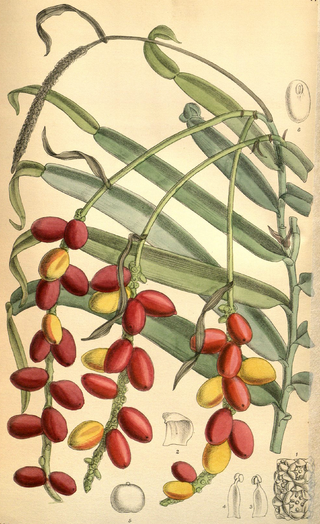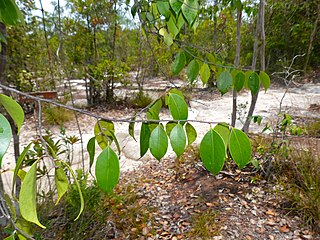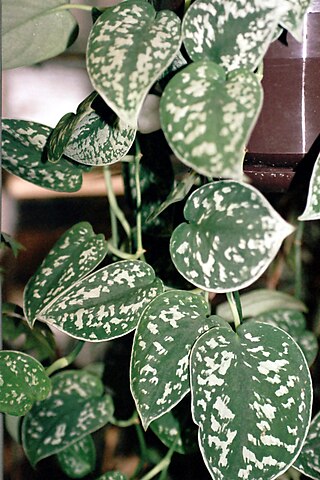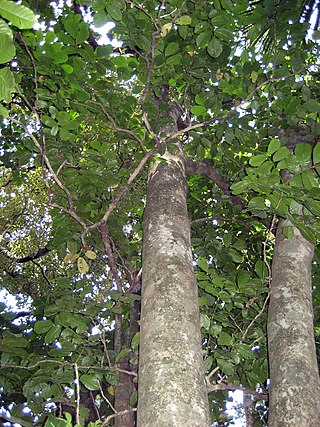
Antidesma is a genus of tropical plant in the family Phyllanthaceae formally described by Linnaeus in 1753. It is native to tropical Africa, S + E + SE Asia, Australia, and various oceanic islands. The greatest diversity occurs in Southeast Asia.

Mallotus is a genus of the spurge family Euphorbiaceae first described as a genus in 1790. Two species are found in tropical Africa and Madagascar, while all others are found in East Asia, the Indian Subcontinent, Southeast Asia, eastern Australia, and certain islands of the western Pacific. The genus has about 150 species of dioecious trees or shrubs.

Canarium is a genus of about 120 species of tropical and subtropical trees, in the family Burseraceae. They grow naturally across tropical Africa, south and southeast Asia, Indochina, Malesia, Australia and western Pacific Islands; including from southern Nigeria east to Madagascar, Mauritius, Sri Lanka and India; from Burma, Malaysia and Thailand through the Malay Peninsula and Vietnam to south China, Taiwan and the Philippines; through Borneo, Indonesia, Timor and New Guinea, through to the Solomon Islands, Vanuatu, New Caledonia, Fiji, Samoa, Tonga and Palau.
Blumeodendron is a genus of dioecious trees of the family Euphorbiaceae first described as a genus in 1873. It is widespread across much of Southeast Asia and Papuasia.

Cleistanthus is a plant genus of the family Phyllanthaceae, tribe Bridelieae, first described as a genus in 1848. It is widespread in much of the Old World Tropics in Asia, Africa, Australia, and various oceanic islands. Cleistanthus collinus is known for being toxic and may be the agent of homicides or suicides.

Kayea is a plant genus in the family Calophyllaceae. Its species range from Bangladesh and the eastern Himalayas to Sri Lanka, Indochina, Peninsular Malaysia, Borneo, Sumatra, the Philippines, New Guinea, and Queensland.

Arenga is a genus of palms, native to Southeast Asia, southern China, New Guinea, and northern Australia. They are small to medium-sized palms, growing to 2–20 m tall, with pinnate leaves 2–12 m long. Arenga palms can grow in areas with little sunlight and relatively infertile soil.

Actinodaphne is an Asian genus of flowering plants in the laurel family (Lauraceae). It contains approximately 125 species of dioecious evergreen trees and shrubs.

Pothos is a genus of flowering plants in the family Araceae. It is native to China, the Indian Subcontinent, Australia, New Guinea, Southeast Asia, and various islands of the Pacific and Indian Oceans.

Orania is a genus of the palm tree family Arecaceae, whose native is Madagascar, Malesia, and New Guinea.

Parastemon is a genus of plant in the family Chrysobalanaceae described as a genus in 1842. It is native to Southeast Asia and to Papuasia.
- Parastemon grandifructusPrance - Sarawak, Sabah
- Parastemon urophyllus(Wall. ex A.DC.) A.DC. - Nicobar Islands, Thailand, Peninsular Malaysia, Borneo, Sumatra
- Parastemon versteeghiiMerr. & L.M.Perry - Sulawesi, Maluku, New Guinea, Admiralty Islands

Anisoptera is a genus of plants in the family Dipterocarpaceae. It contains ten species distributed from Chittagong in southeast of Bangladesh to New Guinea.

Homalomena is a genus of flowering plants in the family Araceae. Homalomena are found in southern Asia and the southwestern Pacific. Many Homalomena have a strong smell of anise. The name derives apparently from a mistranslated Malayan vernacular name, translated as homalos, meaning flat, and mene = moon.

Scindapsus is a genus of flowering plants in the family Araceae. It is native to Southeast Asia, New Guinea, Queensland, and a few western Pacific islands. The species Scindapsus pictus is common in cultivation.

Didymocheton is a genus of flowering plants in the family Meliaceae. It includes 41 species which range from eastern India through Indochina and southern China to Malesia, Papuasia, eastern Australia, New Zealand, and the South Pacific.

Urceola is a plant genus in the family Apocynaceae, first described as a genus in 1798. It is native to China, the Himalayas, Southeast Asia, and New Guinea.

Chisocheton is a genus of trees in the family Meliaceae. The genus name comes from the Greek schizos and chiton meaning "split tunic", referring to the lobed staminal tube of C. patens. Their range is from India and tropical China, throughout Malesia and south to New South Wales and Vanuatu.
Teijsmanniodendron is a genus of flowering plants in the mint family, Lamiaceae, first described in 1904. It is native to Southeast Asia and Papuasia.
Micrechites is a genus of flowering plants in the family Apocynaceae, first described as a genus in 1857. It is native to China, the eastern Himalayas, Southeast Asia, Papuasia, and Queensland.
Atuna excelsa is a species of flowering plant in the family Chrysobalanaceae, native to Thailand to the western Pacific.





















